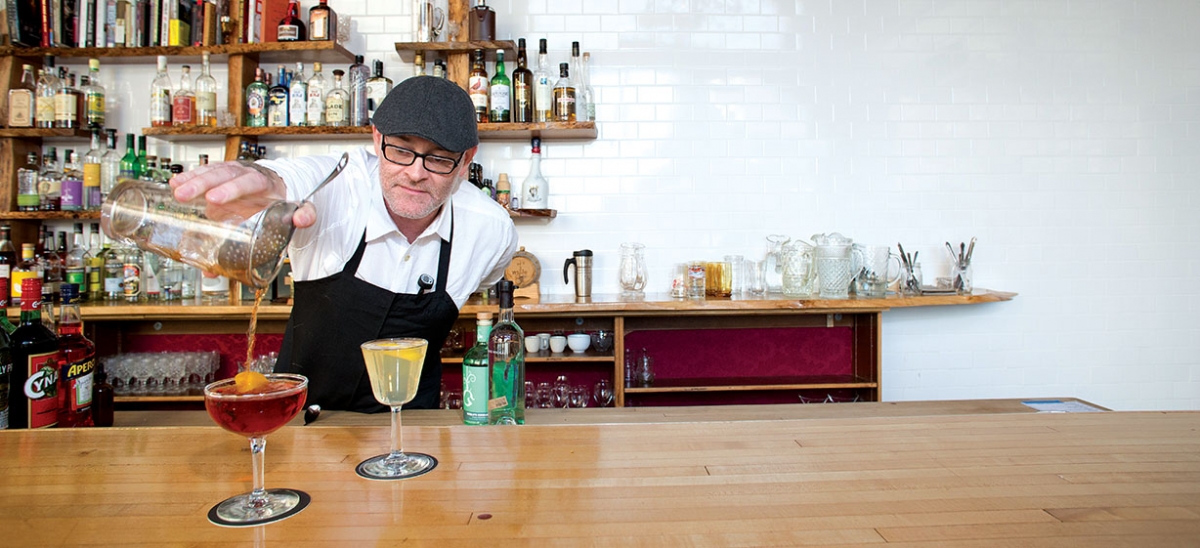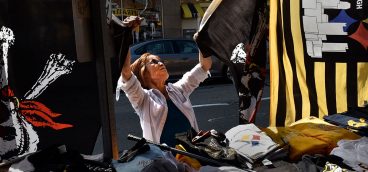Raising a Glass (and a Local Industry)

It is near mayhem inside the headquarters of Pennsylvania Pure Distilleries, a drafty warehouse next door to a glass factory along an industrial stretch of Shaler. A forklift topples over a pile of cardboard boxes waiting to be filled with vodka bottles. Giant fermentation tanks are hot with bubbling CO2. A leg of pantyhose—stuffed with wormwood, tea, mango, and other roots, fruits and spices—bobs inside a 100-liter test pot of vermouth.
[ngg src=”galleries” ids=”93″ display=”basic_thumbnail” thumbnail_crop=”0″]
The distillery’s owners have spent months searching for a new space, but there is little time. With their signature Boyd & Blair vodka winning international accolades, they have quintupled their output since their launch five years ago and become the face of Pittsburgh’s resurgent distilling industry in the process.
Their national distributor was expecting 630 cases of their triple-distilled potato vodka the following week, and even some liquor stores in bourbon-proud Kentucky had made a small order.
“It’s not really a vodka state,” jokes the distillery’s co-owner Barry Young, a laconic former pharmaceutical executive turned mad scientist of spirits. He sets out cups to sample his products-in-progress, including a concentrated vermouth and a throwback rum. He also offers a bit of Falernum, a complicated syrup for tropical drinks held in a quickly depleting bottle.
“I keep drinking it, as you can see,” Young says.
Following the successful path of small-sized beer-makers, craft distilling has boomed the last several years around Pittsburgh and nationwide. When it started producing in 2008, Pennsylvania Pure Distilleries was one of two opened in the state since Prohibition. Since then it has been joined by other start-up distilleries in the area, including Wigle Whiskey in the Strip District.
Where Pennsylvania Pure focuses on national and international markets, Wigle sets its sights on home. Started in 2012 by a family that includes two lawyers, a food industry manager and a Peace Corps member who worked at a brewery in Kyrgyzstan, their distillery tours are in-depth guides into how artisan spirits are crafted, starting with 50-pound bags of local grains and ending with a small bottling line staffed by volunteers.
“We think it is very important what ‘craft’ means—the process. We take it all really seriously,” says Meredith Grelli, a co-owner and former brand manager at H.J. Heinz Co.
Wigle Whiskey, named after one of two frontier rebels nearly hanged after the Whiskey Rebellion, is also the area’s foremost educator on western Pennsylvania’s long-ago dominance in producing whiskey, its biggest export in the days before steel.
Three hundred years ago, rum was America’s preferred drink, but during the 18th century grain whiskey took over, partially due to the influence of Scots-Irish immigrants settling in western Pennsylvania. Lugging bushels of grain over the Allegheny Mountains to markets back east was a chore; it was easier and more lucrative for small farmers to turn it into whiskey, and by the end of the century “Monongahela rye” was reputed as the country’s best. In a still undeveloped land where settlers rarely saw coins, whiskey was used for barter, with subsistence farmers paying their landlords rent in liquor they made from grains and grasses.
That was not the type of economic model desired by President George Washington’s restless treasury secretary Alexander Hamilton. He needed to boost federal bonds to pay off the new country’s Revolutionary War debts, which would free up private merchants to invest in industry. Since those same merchants were already paying taxes on imports, he needed an excise tax on a domestic product.
His solution was a levy on whiskey distillers. It was difficult getting the tax approved—Hamilton’s ally Robert Morris had to deal away Philadelphia’s claims on being the nation’s capital, among other sweeteners—but the levy was finally made law in 1791.
The hardscrabble farmers of western Pennsylvania saw it as an assault on their livelihood that also reminded them of monarchist England, where large distillers favored excise taxes that snuffed out small competition. So the farmers, many of them war veterans, aimed the same ferocity they used fighting Native Americans and the British toward intimidating the new tax collectors. Blackening their faces and wearing women’s dresses, they attacked the first collector assigned to the Pittsburgh area. They stripped him naked, shaved his hair, covered him in hot tar and left him rolled in feathers in the forest. Their angry backlash percolated, with farmers from six counties in western Pennsylvania and Virginia even adopting their own red-and-white-striped rebel flag.
The new federal government responded muscularly in defense of its first domestic tax, culminating in Washington briefly leading 13,000 troops—more than the army that beat the British at Yorktown—toward western Pennsylvania in 1794. Nationally, citizens rallied behind their new government and the rebellion fizzled. “In Washington’s stated opinion, suppressing the Whiskey Rebellion had drawn from the American people the support for law and government that marked their highest character,” wrote William Hogeland in a 2006 book on the conflict. The crackdown led to the arrests of a score of rabble-rousing farmers, though only two, including Philip Wigle, were convicted. Washington pardoned him, and a year after he left the presidency he built one of the largest commercial distilling operations in the nation at Mount Vernon.
Long dormant, Pennsylvania Distilling got its revival in 2012, partially because of new government moves.
Pennsylvania Pure, Wigle and Philadelphia Distilling (makers of the much-praised Bluecoat gin) successfully lobbied for a state law allowing distilleries to sell their products on-site, just as Pennsylvania winemakers could. Those sales were already allowed in 30 other states, which had held back the growth of the local distillery market. The bill, signed by Gov. Tom Corbett, also lowered the annual license fee for small distillers by 80 percent.
The closely held secrets of distilling had seeped out, too. Commercial production of the nation’s foremost homegrown spirit, bourbon, bottomed out in the 1990s, but a rebirth was already in the works, partially due to the corresponding rise of the Internet. Small-scale distillers began to share information on the Web and take classes in the science of mashing ingredients (such as the potato flakes for Boyd & Blair vodka, and the local grains for Wigle’s wheat and rye whiskeys), fermenting them into alcohol, and filtering out impurities.
“It’s easier to learn the craft,” says Wigle Whiskey’s Eric Meyer, the one-time Peace Corps volunteer. “Thirty years ago you’d have to work for one of eight companies—there were literally like 20 jobs available to learn distillation [nationwide]. Now you’re not limited.”
The opening doors led to a 21st century artisanal distilling boom. Rum is the next wave, with both Pennsylvania Pure and Wigle turning them out, followed by another dubbed “Maggie’s Farm” out of Allegheny Distilling in the Strip District. Rum is simpler to make than other spirits—Allegheny’s Tim Russell is using sugar, while Pennsylvania Pure is fermenting molasses from Lancaster, and Wigle is using local buckwheat honey.
Plans are under way in Munhall for the launch of Stay Tuned Distillery to produce whiskey and gin. Others are on the way. Where there were only two distilleries in the state a decade ago, according to the Pennsylvania Liquor Control Board, there were 12 new small ones licensed by late 2013. The business model depends in part on the boutique prices small brands can charge for their handmade products: a 750 milliliter bottle of Boyd & Blair sells for $29.49 and Wigle whiskeys are $32 to $34.
“People are willing to pay for quality,” Russell says. “It’s not all just Budweiser and Bacardi and things like that. People know there’s something better out there.”
The craft liquor boom is related also to customer interest in farm-to-table dining. The value placed on supporting food produced and shipped by local farmers and truck drivers has extended to supporting local craft liquors and the bars that carry them.
Nationwide, many small-scale whiskey producers buy their spirits in bulk from gigantic Kentucky producers such as Jim Beam, Buffalo Trace or Heaven Hill, and then age and blend them to personalize the product. There are only a handful in the nation that are made completely from local grain to whiskey bottle the old-fashioned way. Wigle is one.
“Everything we do is organic, and everything we do is from scratch. It’s all very important to us philosophically,” says Grelli, Meyer’s sister.
Working with local farmers “means they’re getting more flavorful grains and really nice stuff,” says Pittsburgh-based food and alcohol writer Hal B. Klein. “Just like anything else, if you start off with something that good and keep the process streamlined, you’re going to end up with a better product.”
Pennsylvania Pure picked its location off Route 8 simply because it was next to their bottle source at the former Glenshaw Glass factory. Even though it is shipped internationally, is repeatedly judged as one of the best spirits in the world, and has seen 48 percent yearly revenue growth, it is virtually all Pennsylvanian. It is made from Schuylkill County potato flakes and filtered Shaler water and packed in boxes made in New Castle. “Everything but the cork, really, is local,” Young says.
The distillery is learning to grow into its success. At Pennsylvania Pure’s start in 2008 it did two mashes of potato flakes per week. With demand booming this year—September’s order was for 6,000 bottles, up from about 1,200 monthly in 2008—they are toying with two mashes a day. Each mash takes nine days start to finish, and since Boyd & Blair uses only the best parts of the distillation run—the smooth-tasting “hearts” of the fermented potato mash vapors—and throws out the rest, its three main tasters work two eight-hour shifts six days per week. Two workers hand-fill and wax the top of every bottle.
“We stand at the still and literally taste,” Young says. “We don’t have a computer attached to the still, don’t have a digital thermometer. It’s all old-school; there’s no automation.”
Spirit Journal, a widely respected quarterly industry magazine, has judged Boyd & Blair the best vodka among its 120 most-praised spirits for three years running.
Sean Enright of Bar Marco in the Strip District says “in craft cocktails you want the spirit to taste like something. Boyd & Blair does.” Brian Gastaldi, a spirits expert and bartender at Acacia on the South Side, calls Boyd & Blair “a world-class product. That’s not to say it’s necessarily the best, but it is world class.”
But it is still vodka, which is often prized for its lack of character. Pennsylvania Pure’s success at marketing the spirit just at the height of the farm-to-table movement is credited to Prentiss Orr, Young’s partner and a former vice president of the Greater Pittsburgh Area Chamber of Commerce.
“They’re really good at telling the story of where their vodka comes from,” says Klein. “They’re tireless in making sure people know they’re there.”
Next, the distillery is set to introduce a pre-Revolutionary era rum called Stonewall American, of the type settlers would have produced before whiskey. Another new product, a spice-infused concentrate called Balsam, may be the biggest attention-grabber for the company. Made with Boyd & Blair vodka, cocktail enthusiasts will be able to combine it with unused wine to make spectacularly flavored sweet vermouth.
Created by Young, along with two Chicagoans—bitters superstar Adam Seger and Rodrick Markus of the Rare Tea Cellar—the concentrate has already been sold to Singapore, Hong Kong and 30 states nationwide. As it contains the bitter herb wormwood, it will be the only American vermouth officially marketed within the European Union, Young says.
For the Wigle team, the focus on creating new products has been a motivation from the start. Inspired after touring vineyards in Canada, trial lawyer Mark Meyer and his family—wife Mary Ellen, daughter Meredith and her husband, Alex Grelli—discussed the idea of starting a distillery on the drive home. The idea was to create a place—officially called the Pittsburgh Distilling Co.—that would be grounded in the city’s whiskey history of the 1700s. Brothers Eric and Jeff Meyer were roped in as well.
Their model has a built-in challenge: While Wigle recreates an 18th-century product in a relatively short amount of time, most of the country’s best-regarded whiskey producers moved long ago to long-term barrel aging to develop flavor, such as in Kentucky bourbon.
The family is waiting for some of its whiskey to similarly age in 53-gallon casks in the Strip District and a new barrel house in the North Side, a process that takes at minimum four to five years. In the meantime it is planning a seasonal “whiskey garden” to be landscaped with the rye grasses, wheat and botanicals found in their products. All the while it is still producing white rye and white wheat whiskey, an old-fashioned Dutch-style gin and two kinds of bitters. In October it debuted two rums, and next year it plans an Old Tom-style gin, a hopped whiskey, and a smoked whiskey in cooperation with East Liberty barbecue restaurant Union Pig & Chicken.
While contending with the bushels of red tape and worry faced by any small family business, the family focuses on the bubbling, chemical, experimental part of their job. That also keeps them glued to their gleaming, brightly colored Strip District distillery, the only place where bottles of their product are sold, and which hosts giant, lines-around-the-block parties when its new liquors are released.
“We wanted to create a place where people come and learn about the spirits, that was an educational place and community gathering spot,” Grelli says. “What that allows us to do is focus on innovation… If we know we can sell 500 bottles of something, we’ll try it.”




